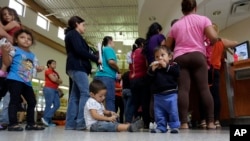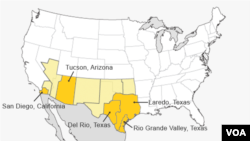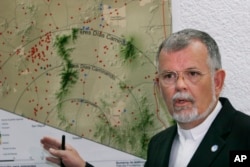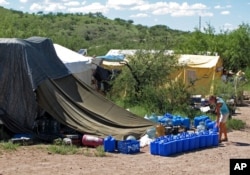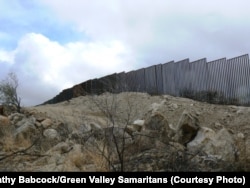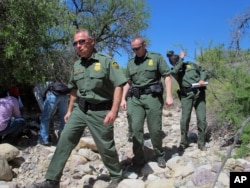Kathy Babcock’s involvement with immigration issues began with a knock on her door.
Three days after she moved to Green Valley, Arizona, two Mexican migrants who had crossed the border knocked, asking for food and water.
“We had no idea what was going on here,” said Babcock, who had recently moved from the San Francisco area to the retirement community, which is located about 70 kilometers from the border. “We gave them food and water and $10 and pointed them north.”
She soon became involved with a group called the Green Valley Samaritans, whose mission “is to save lives in the desert,” she said, noting their group has about 100 active volunteers, almost all of them retirees, and is funded by donations.
Like Babcock, many of the dozens of organizations and volunteer groups that work along the U.S.-Mexico border became involved, and continue to operate, because of the immigration concerns they see occurring in their own backyard.
The groups have one common goal: no more deaths of migrants crossing illegally into the United States.
The groups say Operation Gatekeeper, a border enforcement policy enacted in 1994, has led to a marked increase in migrant injuries and deaths. The operation concentrated border agents and added walls and fencing in populated areas.
The result: it forced migrants trying to cross the border into increasingly remote, harsh environments, using natural barriers as a deterrent.
A 2009 report by the American Civil Liberties Union stated: Since Operation Gatekeeper went into effect in 1994, an estimated 5,600 migrants have died while attempting unauthorized border crossings.
Enrique Morones, the president and founder of San Diego-based Border Angels, said that number has now grown to more than 10,000 deaths.
Water, food drops
In response to migrants dying in these conditions, many longtime groups, such as Humane Borders, No More Deaths and Border Angels, place water, food and other essentials along well-traveled paths that migrants use in the deserts from Texas to California.
Juanita Molina, executive director of Humane Borders, said dehydration is the No. 1 cause of death among those crossing the border.
Humane Borders, beginning in 2000, started maintaining a network of dozens of water stations – ranging from a single 250-liter barrel of water to a half-dozen barrels – in remote locations in Arizona and across the border in Mexico. A map of the locations is available on their website.
The land that migrants travel across is high desert, Molina said. “I think it’s very difficult to understand. What we’re looking at here in the desert is you have the vast wilderness, extreme heat and lack of water.
“It’s possible for someone to be perfectly healthy and to die within 48 hours,” she said.
In addition to the water stations, Humane Borders has joined the Pima County, Arizona, medical examiner in mapping the deaths of migrants attempting to cross the Arizona-Mexico border, Molina said.
Between October 1999 and June 2013, Humane Borders collected data on more than 2,400 migrant deaths in Pima County.
The Arizona OpenGIS Initiative for Deceased Migrants allows family members who have lost a loved one to find the location where they died and, when possible, the cause of death, Molina said. Among the main causes of death, when a cause can be found, is exposure and blunt-force trauma.
The Tucson sector, which covers much of the Arizona border, and the Rio Grande Valley sector in Texas are the most deadly for migrants crossing the border, according to the U.S. Customs and Border Protection. In 2013, 194 people died in the Tucson sector; 156 died in the Rio Grande Valley sector.
Earlier this month, the Border Patrol said it had identified more than 220 deaths along the Southwest border, including 34 water-related deaths, so far this year.
Molina noted that migration is down by all accounts and yet “we find over 150 remains each year and we aren’t actively searching.”
It “was always the hope when the organization started – we would put out water and show the rate of deaths and the government would be horrified and we’d find an end to this,” Molina said. “That hasn’t happened.”
Humanitarian presence
Maryada Vallet, a media spokesperson with No More Deaths, founded in 2004, said the group’s volunteers run year-round camps in remote sections of the Arizona desert. They hike the Sonoran desert, mapping migration trails and leaving water, food and other critical items along high-traffic paths.
In the past 10 years, she said the group has maintained its core desert aid work, but they have adapted to changes along the border.
In 2006, they began providing support to the thousands of undocumented migrants being deported from the U.S. to Mexico, Vallet said.
These were people, Vallet said, “who had lived in the U.S. for 20-30 years … who hardly spoke Spanish anymore,” and they were being left to fend for themselves in towns across the border.
Their group works in the border towns of Nogales, Sonora, and Agua Prieta, Mexico, providing aid to recent deportees, including an orientation to the towns as well as how to contact family members from whom they’ve been separated.
They also provide witness in the desert to what they call a “low-grade war zone,” Vallet said.
No More Deaths has begun to document abuse suffered by the migrants in short-term border custody, Vallet said. The group’s 2011 report, A Culture of Cruelty, documented more than 30,000 incidents of abuse and mistreatment of detainees over a three-year period, Vallet said.
She said detainees, who are usually held less than 72 hours, say they have endured verbal and physical abuse while in custody, medical negligence, loss of belongings and repatriation at night.
With this information, Vallet said, it’s “concerning that so many thousands of children are in custody now.”
Driving the desert
The Green Valley Samaritans have found hundreds of migrants by traveling the old mining roads between their town and the border crossing near Sasabe, Arizona, Babcock said.
These roads are deceiving, she said. When migrants get in trouble in the desert – they have lost their group, they are unable to walk because of injury, or they are elderly or young, tired or ill – they head for a road, thinking someone will travel by, she said.
But these roads don’t get much traffic, said Babcock, 68, who regularly goes out on searches with her partners, who are 78 and 83 years old.
Of the people they do find, 90 percent of them “want to go back to where they came from,” she said.
In those cases, they call the Border Patrol, who will send an agent to pick up the migrant.
If migrants want to go on, though, Samaritans caution them about the dangers of crossing the desert and explain about the checkpoints in the distance. They can’t give migrants a map, so they will point them in the right direction. And the group’s members always send off the migrants with water and food, first aid supplies, clean socks and a hat, she said.
The Samaritans also clean up the trash left by migrants traveling through the desert. They find “lots of cans of Red Bull and bottles of No-Doz,” she said, adding that coyotes (traffickers) often feed the migrants these items to keep them walking and to walk faster.
They also find packages of birth control, she said. Some women, Babcock said, fearing they will be raped on the journey, take birth control to prevent pregnancy.
Border Patrol
Victor Brabble, Customs and Border Protection spokesperson for Arizona, said the agency shares a common goal with the humanitarian groups: mitigating deaths in the border region.
But "do we see eye to eye with these groups all the time? No," Brabble said. “We don’t work side-by-side with them, but we do share the same mission.”
He said the agency shares with the groups information about some aspects of their mission, such as a recent rescue beacon program.
The Border Patrol has erected in the desert nearly two dozen nine-meter-tall beacons that shine a blue light that is visible for kilometers. The beacons have signs in three languages that direct users to push a red button that sends out a signal for help, and border agents respond.
He said the agency has about 5,000 agents on the Arizona border. Many are trained first-responders, because enforcement can often lead to search-and-rescue efforts by the agents, he said.
Over the July 4th holiday, Brabble said border agents rescued a diabetic migrant who had fallen ill and been left behind by his group.
Brabble said border agents are told not to interfere with humanitarian groups' efforts.
However, No More Deaths videotaped border agents vandalizing water drops last year. Brabble said that did happen, and the agents were dealt with and instructed not to interfere with the group's efforts.
While Babcock said the Samaritan volunteers have never been threatened or seen evidence of drug trafficking, Brabble said the Border Patrol has warned the humanitarian groups of the potential for danger.
“We urge our humanitarian groups to proceed with caution. You don’t know who you’re dealing with,” he said, adding the migrants could be criminals, gang members or drug traffickers.
Aligned with law enforcement
That's just what Jim Gibson, executive vice president and media liaison for the Texas Border Volunteers, said he see in Brooks County, Texas.
Gibson said of the migrants that have been apprehended in the county, many have links to Mexican gangs, such as MS13 and La Hermandad de Pistoleros Latinos.
Brooks County is part of the Border Patrol’s Laredo sector, which ranks third in both migrant apprehensions and deaths, as well as drug seizures, according to patrol statistics. Yet the county lies more than 100 kilometers from the border.
The TBV, which started as part of the Minutemen Civil Defense Corps in Arizona, broke away and formed their own group, focusing on Texas-specific issues and becoming more proactive in aligning themselves with law enforcement, he said.
The group works closely with Border Patrol and local law enforcement, conducting surveillance watches about eight times a year, Gibson said.
Members will conceal themselves on private land and, using night-vision and thermal-imaging equipment, identify, observe and report to border agents the groups or individual migrants they see. Many times, the groups will walk right by the concealed members, he added.
Unlike groups that provide humanitarian aid to migrants, Gibson said the TBV tries to avoid contact with the migrant groups. In fact, they have a strict no-contact policy, he said, for several reasons, including group members have no way to know if a migrant has a criminal background or is ill.
Also, he said, if they cause a group to scatter, it makes the Border Patrol's job harder in locating the migrants, and could cause some migrants to get lost in the rugged countryside.
Gibson described the terrain in Brooks County, which has a population of about 7,000, as harsh – filled with heavy brush, sandy soil that makes it difficult for foot traffic, triple-digit temperatures in summer.
“If you get lost out there and don’t know what you’re doing, don’t have food and water,” you could die, Gibson said.
“In the process of reporting these people,” he said, “we’re saving lives.”
Central American influx
The humanitarian crisis caused by a recent influx of migrants from Central America crossing the U.S.-Mexico border is no surprise to the many organizations and volunteer groups who work there.
All the humanitarian groups interviewed said that, up until about 2006, the majority of those crossing the border illegally were Mexican migrants looking for work.
But about three years ago, the groups said they started to see a dramatic shift in the migrant population, to people from basically three Central American countries: Honduras, Guatemala and El Salvador.
“This current phenomenon shouldn’t be called a surge,” said Vallet, of No More Borders. “We’ve seen this increase steadily over the last few years, in women and children from Central America.”
The reason for the crossings changed as well, they said, from migrants looking to make a living to feed their families to those escaping violence, poverty and gang activity.
Texas’ Rio Grande Valley is not only the No. 1 spot for migrant apprehensions along the Southwest U.S. border, but it also has become the most popular crossing area for Central American migrants.
Since October 2013, Border Patrol agents have apprehended nearly 43,000 migrants trying to cross the border in the Rio Grande Valley.
A collective of south Texas community and faith organizations, known as South Texas Refugee Response, joined efforts, setting up a short-term shelter on June 10. Since then, they have helped more than 3,200 people.
For the Brownsville diocese, the response to the humanitarian crisis began as a grassroots effort, said Brenda Riojas, communications director for the Catholic Diocese of Brownsville.
Earlier this year, local parishioners witnessed migrant women and children being dropped off at the bus station in McAllen, Texas.
The women and children had been caught illegally crossing the U.S. border, and after being detained and given hearing dates to appear before immigration courts, were released to find family members living elsewhere in the United States.
Riojas said many of the women and children were in need - tired, confused, unsure of how to contact family members in some cases.
At first, parishioners started providing humanitarian aid, food and water, from the trunks of their cars at the bus station, she said.
As the numbers grew, though, officials at the bus station requested Catholic Charities’ help, saying their space was not suitable for the services the volunteers were providing.
Community steps up
Riojas said the organizations throughout the community, and especially the city of McAllen, stepped up and provided multiple services to the migrants.
The Salvation Army provides meals, Save the Children works with the children, allowing the mothers to shower, rest or make travel arrangements. The local municipality brought in portable showers, doctors donate their time, and one private donor even provided the use of a medical unit.
Two parishes – Immaculate Conception Cathedral in Brownsville and Sacred Heart Church in McAllen – provide space for the families. Some women and children stay just long enough to catch the next bus, but most stay for about 24 hours, long enough to shower and arrange travel.
On a recent day in San Diego, Morones, of the Border Angels, was working with college student volunteers who had planned to deliver water to the desert as well as helping recent detainees - a woman and her young daughter who had made the long trek from El Salvador - coordinate travel plans to find relatives in the U.S.
The mother and daughter came, he said, because the daughter, who is just seven years old, had witnessed a man get killed and the mother feared for her daughter’s life.
Project manager Lonnie Briseno said Project Oak Tree, an effort by the Roman Catholic Diocese of Las Cruces, started providing aid on July 2 and has helped about 80 migrants from Central America so far.
By the time the refugees arrive in Las Cruces, he said, “Some have been very distraught. Some women were separated from their husbands at the border and they don’t know where their husbands are.”
Medically, many are tired, dehydrated and emotionally drained, Briseno said.
Earlier this month, the Border Patrol launched an ad campaign directed at Central America residents who are considering crossing the U.S. border.
Brabble said the campaign stresses the many dangers of trying to cross the border and tries to dissuade migrants from making that decision.
The U.S. Department of Immigration and Customs Enforcement (ICE) said in a statement that it has worked with several non-governmental organizations regarding migrant detainees.
Danielle Bennett, a spokesperson for (ICE), said in a statement that ICE’s Enforcement and Removal Operations (ERO) officers in Arizona work with the Florence Immigrant and Refugee Rights Project regarding their mission to provide legal access and assistance to detained aliens.
ICE’s ERO El Paso officers work closely and have long-standing working relationships with NGOs and faith-based groups that provide social services for aliens released in El Paso, the statement read.
In 2013, the Border Patrol apprehended more than 400,000 migrants crossing the Southwest U.S. border. Since October of last year, 50,000 unaccompanied children, as well as 39,000 adults and children, have been caught crossing the border, according to the Obama administration.
Border Facts
Border Facts
- The border between the United States and Mexico is 3,110 kilometers long.
- About 1,050 kilometers of border fence exist in parts of California, Arizona and Texas.
- Border fence consists of 480 kilometers of vehicle barriers and 560 kilometers of pedestrian barriers.
- U.S. Customs and Border Patrol had more than 21,000 employees in fiscal 2013.
- More than 18,000 CBP employees are stationed along the Southwestern U.S. border.
Humanitarian crisis
President Barack Obama recently asked Congress for $3.7 billion to address the huge influx of Central American migrants attempting to cross into Texas, calling the situation “an urgent humanitarian crisis.”
Several of the groups said they were pleased with his word choice. However, they said his response to the crisis – the proposal includes more money for border enforcement and speedier deportation hearings - is anything but humanitarian.
“With his request, he’s treating it as more of a homeland security issue and enforcement issue, instead of a humanitarian one,” No More Death’s Vallet said. “More enforcement isn’t part of the answer … it’s leading to the problem.”
Border Angels’ Morones agreed, saying, “A humanitarian crisis needs a humanitarian response. Deporting them is not a humanitarian response,” he said. “The best thing the president could do is have humane reform.”
Morones said for all the debate over immigration, no one has bothered to ask the migrants themselves why they are crossing.
“We’re talking to these families. They just want to be documented,” he said.
There are three main reasons the migrants come, Morones said. “The No. 1 reason, they want to put food on their table. No. 2, they want to be with their families already in the U.S. No. 3, they want to escape the violence. The most violent countries in the Americas” are Honduras, Guatemala and El Salvador.
Riojas, of the Brownsville diocese, said what their volunteers are hearing from the migrants is they just want a safe place to raise their children.
“I don’t think anyone has an easy answer” to this current crisis, she said. “We do have to consider that they are refugees – they’re not leaving to come here for vacation. They’re leaving because the situation in their home country makes it very challenging to raise a family. They’re trying to find a safe space.
“The world is watching how we’re reacting to this humanitarian crisis,” Riojas added. The women and children who come here “want a safe place for their families to grow. Simply returning them to their home countries is not an answer.”




